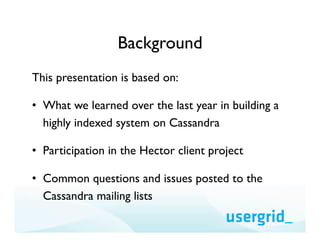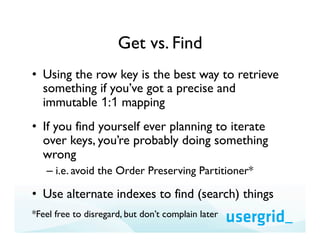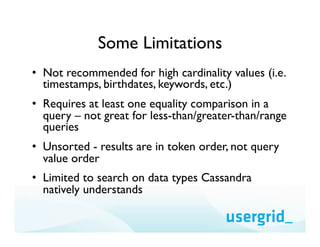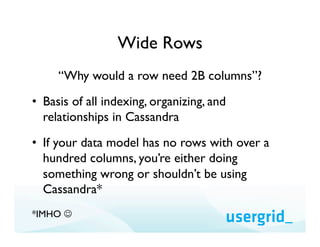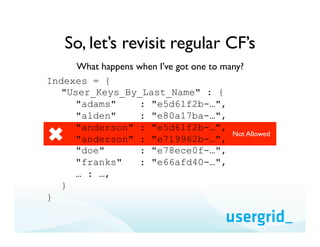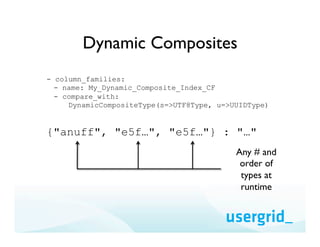Ad
Indexing in Cassandra
- 1. Cassandra Indexing Techniques Ed Anuff Founder, Usergrid Cassandra Summit SF July, 2011
- 2. Agenda • Background • Basics of Indexes • Native Secondary Indexes • "Wide rows" and CF-based Indexes • Inverted-indexes Using SuperColumns • Inverted-indexes Using Composite Columns • Q&A
- 3. Background This presentation is based on: • What we learned over the last year in building a highly indexed system on Cassandra • Participation in the Hector client project • Common questions and issues posted to the Cassandra mailing lists
- 4. Brief History - Cassandra 0.6 • No built-in secondary indexes • All indexes were custom-built, usually using super-columns • Pros – Forced you to learn how Cassandra works • Cons – Lots of work – Super-columns proved a dead-end
- 5. Brief History - Cassandra 0.7 • Built-in secondary indexes • New users flocked to these • Pros – Easy to use, out of the box • Cons – Deceptively similar to SQL indexes but not the same – Reinforce data modeling that plays against Cassandra’s strengths
- 6. Present Day • New users can now get started with Cassandra without really understanding it (CQL, etc.) • Veteran users are using advanced techniques (Composites, etc.) that aren’t really documented anywhere* • New user panic mode when they try to go to the next level and suddenly find themselves in the deep end *Actually, they are, Google is your friend…
- 7. Let’s try to bridge the gap…
- 8. A Quick Review There are essentially two ways of finding rows: The Primary Index (row keys) Alternate Indexes (everything else)
- 9. The “Primary Index” • The “primary index” is your row key* • Sometimes it’s meaningful (“natural id”): Users = { "edanuff" : { email: "[email protected]" } } *Yeah. No. But if it helps, yes.
- 10. The “Primary Index” • The “primary index” is your row key* • But usually it’s not: Users = { "4e3c0423-aa84-11e0-a743-58b0356a4c0a" : { username: "edanuff", email: "[email protected]" } } *Yeah. No. But if it helps, yes.
- 11. Get vs. Find • Using the row key is the best way to retrieve something if you’ve got a precise and immutable 1:1 mapping • If you find yourself ever planning to iterate over keys, you’re probably doing something wrong – i.e. avoid the Order Preserving Partitioner* • Use alternate indexes to find (search) things *Feel free to disregard, but don’t complain later
- 12. Alternate Indexes Anything other than using the row key: • Native secondary indexes • Wide rows as lookup and grouping tables • Custom secondary indexes Remember, there is no magic here…
- 13. Native Secondary Indexes • Easy to use • Look (deceptively) like SQL indexes, especially when used with CQL CREATE INDEX ON Users(username); SELECT * FROM Users WHERE username="edanuff";
- 14. Under The Hood • Every index is stored as its own "hidden" CF • Nodes index the rows they store • When you issue a query, it gets sent to all nodes • Currently does equality operations, the range operations get performed by in memory by coordinator node
- 15. Some Limitations • Not recommended for high cardinality values (i.e. timestamps, birthdates, keywords, etc.) • Requires at least one equality comparison in a query – not great for less-than/greater-than/range queries • Unsorted - results are in token order, not query value order • Limited to search on data types Cassandra natively understands
- 16. I can’t live with those limitations, what are my options? Complain on the mailing list Switch to Mongo Build my indexes in my application
- 17. That sounds hard… Actually, it’s not, but it does require us to revisit some of Cassandra’s unique features
- 18. Wide Rows “Why would a row need 2B columns”? • Basis of all indexing, organizing, and relationships in Cassandra • If your data model has no rows with over a hundred columns, you’re either doing something wrong or shouldn’t be using Cassandra* *IMHO J
- 19. Conventional Rows As Records Users = { "4e3c0423-…” : { username: "edanuff", email: "[email protected]", … : … }, "e5d61f2b-…” : { username: "jdoe", email: "[email protected]", … : … } }
- 20. Wide Row For Grouping Departments = { "Engineering" : { "e5d61f2b-…" : null, "e5d61f2b-…" : null, Column names "e66afd40-…" : null, are keys of rows "e719962b-…" : null, in “Users” CF "e78ece0f-…" : null, "e80a17ba-…" : null, … : …, } }
- 21. Wide Row As A Simple Index Comparator = “UTF8Type” Indexes = { "User_Keys_By_Last_Name" : { "adams" : "e5d61f2b-…", "alden" : "e80a17ba-…", "anderson" : "e5d61f2b-…", "davis" : "e719962b-…", "doe" : "e78ece0f-…", "franks" : "e66afd40-…", … : …, } }
- 22. Column Families As Indexes • CF column operations very fast • Column slices can be retrieved by range, are always sorted, can be reversed, etc. • If target key a TimeUUID you get both grouping and sort by timestamp – Good for inboxes, feeds, logs, etc. (Twissandra) • Best option when you need to combine groups, sort, and search – Search friends list, inbox, etc.
- 23. But, only works for 1:1 What happens when I’ve got one to many? Indexes = { "User_Keys_By_Last_Name" : { "adams" : "e5d61f2b-…", "alden" : "e80a17ba-…", "anderson" : "e5d61f2b-…", ✖! "anderson" : "e719962b-…", Not Allowed "doe" : "e78ece0f-…", "franks" : "e66afd40-…", … : …, } }
- 24. SuperColumns to the rescue? Indexes = { "User_Keys_By_Last_Name" : { "adams" : { "e5d61f2b-…" : null }, "anderson" : { "e5d61f2b-…" : null, "e66afd40-…" : null } } }
- 25. Use with caution • Not officially deprecated, but not highly recommended either • Sorts only on the supercolumn, not subcolumn • Some performance issues • What if I want more nesting? – Can subcolumns have subcolumns? NO! • Anecdotally, many projects have moved away from using supercolumns
- 26. So, let’s revisit regular CF’s What happens when I’ve got one to many? Indexes = { "User_Keys_By_Last_Name" : { "adams" : "e5d61f2b-…", "alden" : "e80a17ba-…", "anderson" : "e5d61f2b-…", ✖! "anderson" : "e719962b-…", Not Allowed "doe" : "e78ece0f-…", "franks" : "e66afd40-…", … : …, } }
- 27. So, let’s revisit regular CF’s What if we could turn it back to one to one? Indexes = { "User_Keys_By_Last_Name" : { {"adams", 1} : "e5d…", {"alden", 1} : "e80…", {"anderson", 1} : "e5f…", ✔! {"anderson", 2} : "e71…", Allowed!!! {"doe", 1} : "e78…", {"franks", 1} : "e66…", … : …, } }
- 28. Composite Column Names Comparator = “CompositeType” or “DynamicCompositeType” {"anderson", 1, 1, 1, …} : "e5f…" 1..N Components Build your column name out of one or more “component” values which can be of any of the columns types Cassandra supports (i.e. UTF8, IntegerType, UUIDType, etc.)
- 29. Composite Column Names Comparator = “CompositeType” or “DynamicCompositeType” {"anderson", 1, 1, 1, …} : "e5f…" {"anderson", 1, 1, 2, …} : "e5f…" {"anderson", 1, 2, 1, …} : "e5f…" {"anderson", 1, 2, 2, …} : "e5f…" Sorts by component values using each component type’s sort order Retrieve using normal column slice technique
- 30. Two Types Of Composites - column_families: - name: My_Composite_Index_CF - compare_with: CompositeType(UTF8Type, UUIDType) - name: My_Dynamic_Composite_Index_CF - compare_with: DynamicCompositeType(s=>UTF8Type, u=>UUIDType) Main difference for use in indexes is whether you need to create one CF per index vs one CF for all indexes with one row per index
- 31. Static Composites - column_families: - name: My_Composite_Index_CF - compare_with: CompositeType(UTF8Type, UUIDType) {"anuff", "e5f…"} : "e5f…" Fixed # and order defined in column configuration
- 32. Dynamic Composites - column_families: - name: My_Dynamic_Composite_Index_CF - compare_with: DynamicCompositeType(s=>UTF8Type, u=>UUIDType) {"anuff", "e5f…", "e5f…"} : "…" Any # and order of types at runtime
- 33. Typical Composite Index Entry {<term 1>, …, <term N>, <key>, <ts>} <term 1…N> - terms to query on (i.e. last_name, first_name) <key> - target row key <ts> - unique timestamp, usually time-based UUID
- 34. How does this work? • Queries are easy – regular column slice operations • Updates are harder – Need to remove old value and insert the new value – Uh oh, read before write??!!!
- 35. Example – Users By Location • We need 3 Column Families (not 2) • First 2 CF’s are obvious: – Users – Indexes • We also need a third CF: – Users_Index_Entries
- 36. Users CF Comparator = “BytesType” Users = { <user_key> : { "username" : "…", "location" : <location>, … : …, } }
- 37. Indexes CF Comparator = “CompositeType” Indexes = { "Users_By_Location" : { {<location>, <user_key>, <ts>} : …, … : …, } }
- 38. Users Index Entries CF Comparator = “CompositeType” Users_Index_Entries = { <user_key> : { {"location", <ts 1>} : <location 1>, {"location", <ts 2>} : <location 2>, {"location", <ts N>} : <location N>, {"last_name", <ts 1>} : "…", … : …, } }
- 39. Users Index Entries CF Comparator = “CompositeType” Users_Index_Entries = { <user_key> : { {"location", <ts 1>} : <location 1>, {"location", <ts 2>} : <location 2>, {"location", <ts N>} : <location N>, {"last_name", <ts 1>} : "…", … : …, } }
- 40. Users Index Entries CF Comparator = “CompositeType” Users_Index_Entries = { <user_key> : { {"location", <ts 1>} : <location 1>, {"location", <ts 2>} : <location 2>, {"location", <ts N>} : <location N>, {"last_name", <ts 1>} : "…", … : …, } }
- 41. Updating The Index • We read previous index values from the Users_Index_Entries CF rather than the Users CF to deal with concurrency • Columns in Index CF and Users_Index_Entries CF are timestamped so no locking is needed for concurrent updates
- 42. Get Old Values For Column SELECT {"location"}..{"location",*} FROM Users_Index_Entries WHERE KEY = <user_key>; BEGIN BATCH DELETE {"location", ts1}, {"location", ts2}, … FROM Users_Index_Entries WHERE KEY = <user_key>; DELETE {<value1>, <user_key>, ts1}, {<value2>, <user_key>, ts2}, … FROM Users_By_Location WHERE KEY = <user_key>; UPDATE Users_Index_Entries SET {"location", ts3} = <value3> WHERE KEY = <user_key>; UPDATE Indexes SET {<value3>, <user_key>, ts3) = null WHERE KEY = "Users_By_Location"; UPDATE Users SET location = <value3> WHERE KEY = <user_key>; APPLY BATCH
- 43. Remove Old Column Values SELECT {"location"}..{"location",*} FROM Users_Index_Entries WHERE KEY = <user_key>; BEGIN BATCH DELETE {"location", ts1}, {"location", ts2}, … FROM Users_Index_Entries WHERE KEY = <user_key>; DELETE {<value1>, <user_key>, ts1}, {<value2>, <user_key>, ts2}, … FROM Users_By_Location WHERE KEY = <user_key>; UPDATE Users_Index_Entries SET {"location", ts3} = <value3> WHERE KEY = <user_key>; UPDATE Indexes SET {<value3>, <user_key>, ts3) = null WHERE KEY = "Users_By_Location"; UPDATE Users SET location = <value3> WHERE KEY = <user_key>; APPLY BATCH
- 44. Insert New Column Values In Index SELECT {"location"}..{"location",*} FROM Users_Index_Entries WHERE KEY = <user_key>; BEGIN BATCH DELETE {"location", ts1}, {"location", ts2}, … FROM Users_Index_Entries WHERE KEY = <user_key>; DELETE {<value1>, <user_key>, ts1}, {<value2>, <user_key>, ts2}, … FROM Users_By_Location WHERE KEY = <user_key>; UPDATE Users_Index_Entries SET {"location", ts3} = <value3> WHERE KEY = <user_key>; UPDATE Indexes SET {<value3>, <user_key>, ts3) = null WHERE KEY = "Users_By_Location"; UPDATE Users SET location = <value3> WHERE KEY = <user_key>; APPLY BATCH
- 45. Set New Value For User SELECT {"location"}..{"location",*} FROM Users_Index_Entries WHERE KEY = <user_key>; BEGIN BATCH DELETE {"location", ts1}, {"location", ts2}, … FROM Users_Index_Entries WHERE KEY = <user_key>; DELETE {<value1>, <user_key>, ts1}, {<value2>, <user_key>, ts2}, … FROM Users_By_Location WHERE KEY = <user_key>; UPDATE Users_Index_Entries SET {"location", ts3} = <value3> WHERE KEY = <user_key>; UPDATE Indexes SET {<value3>, <user_key>, ts3) = null WHERE KEY = "Users_By_Location"; UPDATE Users SET location = <value3> WHERE KEY = <user_key>; APPLY BATCH
- 46. Frequently Asked Questions • Do I need locking for concurrency? – No, the index will always be eventually consistent • What if something goes wrong? – You will have to have provisions to repeat the batch operation until it completes, but its idempotent, so it’s ok • Can’t I get a false positive? – Depending on updates being in-flight, you might get a false positive, if this is a problem, filter on read • Who else is using this approach? – Actually very common with lots of variations, this isn’t the only way to do this but at least composite format is now standard
- 47. Some Things To Think About • Indexes can be derived from column values – Create a “last_name, first_name” index from a “fullname” column – Unroll a JSON object to construct deep indexes of serialized JSON structures • Include additional denormalized values in the index for faster lookups • Use composites for column values too not just column names
- 48. How can I learn more? Sample implementation using Hector: https://github.com/edanuff/CassandraIndexedCollections JPA implementation using this for Hector: https://github.com/riptano/hector-jpa Jira entry on native composites for Cassandra: https://issues.apache.org/jira/browse/CASSANDRA-2231 Background blog posts: http://www.anuff.com/2011/02/indexing-in-cassandra.html http://www.anuff.com/2010/07/secondary-indexes-in-cassandra.html
- 49. What is Usergrid? • Cloud PaaS backend for mobile and rich-client applications • Powered by Cassandra • In private Beta now • Entire stack to be open-sourced in August so people can run their own • Sign up to get admitted to Beta and to be notified when about source code http://www.usergrid.com
- 50. Thank You



